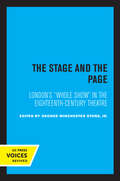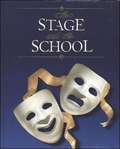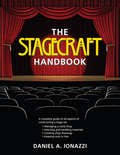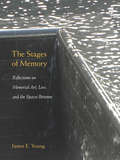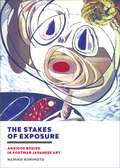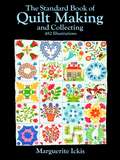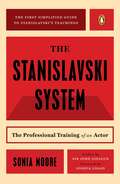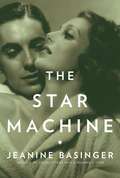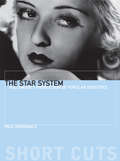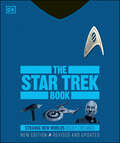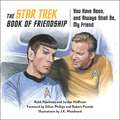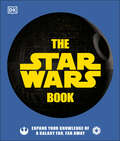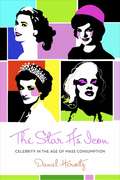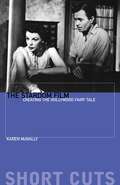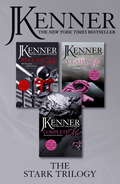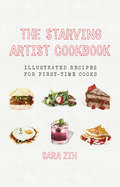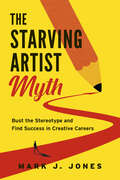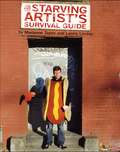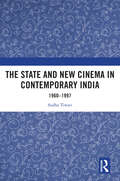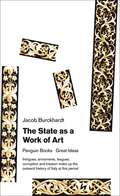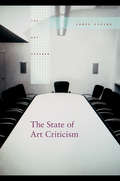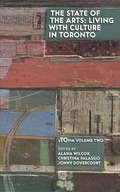- Table View
- List View
The Stage and the Page: London's Whole Show in the Eighteenth-Century Theatre (Clark Library Professorship, UCLA #6)
by Geo. Winchester StoneThis title is part of UC Press's Voices Revived program, which commemorates University of California Press’s mission to seek out and cultivate the brightest minds and give them voice, reach, and impact. Drawing on a backlist dating to 1893, Voices Revived makes high-quality, peer-reviewed scholarship accessible once again using print-on-demand technology. This title was originally published in 1981.
The Stage and the School
by Harry H. Schanker Katharine Anne OmmanneyThe Stage and the School offers more of what you've always loved about the nation's most comprehensive high school drama program. More hands-on exercises. More teacher support. More discussion of the conventions of the theatre. More opportunities to creative expression through performance. More connections to the other arts. With all the hands-on exercises and application activities, scenes and monologues, chapter openers and reviews, students are provided with every opportunity for success.
The Stagecraft Handbook
by Daniel IonazziGet the complete, illustrated guide to scenery construction Using nails and wood, fabric and paint, hardware and rigging, you create an illusion. You build the make-believe world of the play. Now you have a scene-shop manual to help you. In The Stagecraft Handbook, Daniel A. Ionazzi, director of production for the UCLA Department of Theater, offers trap-room-to-grid guidance. Clearly written, heavily illustrated, this book covers every aspect of scenery construction. Turn here and learn about: the four primary stage configurations–proscenium, thrust, arena and environmental flying scenery and moving floors organizing the scene shop to make good scenery quickly and inexpensively shop tools and safety scaled drawings, models and other communications tools you'll use to translate the designer's vision into a set materials commonly used in building scenery construction techniques for flats, platforms and other standard scenic units installing and rigging scenery maintaining an inventory of stock scenery Let The Stagecraft Handbook help you turn ordinary materials into extraordinary illusions.
The Stages of Memory: Reflections on Memorial Art, Loss, and the Spaces Between (Public History In Historical Perspective Ser.)
by James E. YoungFrom around the world, whether for New York City’s 9/11 Memorial, at exhibits devoted to the arts of Holocaust memory, or throughout Norway’s memorial process for the murders at Utøya, James E. Young has been called on to help guide the grief stricken and survivors in how to mark their losses. This poignant, beautifully written collection of essays offers personal and professional considerations of what Young calls the “stages of memory,” acts of commemoration that include spontaneous memorials of flowers and candles as well as permanent structures integrated into sites of tragedy. As he traces an arc of memorial forms that spans continents and decades, Young returns to the questions that preoccupy survivors, architects, artists, and writers: How to articulate a void without filling it in? How to formalize irreparable loss without seeming to repair it? Richly illustrated, the volume is essential reading for those engaged in the processes of public memory and commemoration and for readers concerned about how we remember terrible losses.
The Stakes of Exposure: Anxious Bodies in Postwar Japanese Art
by Namiko KunimotoHow would artistic practice contribute to political change in post–World War II Japan? How could artists negotiate the imbalanced global dynamics of the art world and also maintain a sense of aesthetic and political authenticity? While the contemporary art world has recently come to embrace some of Japan&’s most daring postwar artists, the interplay of art and politics remains poorly understood in the Americas and Europe. The Stakes of Exposure fills this gap and explores art, visual culture, and politics in postwar Japan from the 1950s to the 1970s, paying special attention to how anxiety and confusion surrounding Japan&’s new democracy manifested in representations of gender and nationhood in modern art. Through such pivotal postwar episodes as the Minamata Disaster, the Lucky Dragon Incident, the budding antinuclear movement, and the ANPO protests of the 1960s, The Stakes of Exposure examines a wide range of issues addressed by the period&’s prominent artists, including Tanaka Atsuko and Shiraga Kazuo (key members of the Gutai Art Association), Katsura Yuki, and Nakamura Hiroshi. Through a close study of their paintings, illustrations, and assemblage and performance art, Namiko Kunimoto reveals that, despite dissimilar aesthetic approaches and divergent political interests, Japanese postwar artists were invested in the entangled issues of gender and nationhood that were redefining Japan and its role in the world. Offering many full-color illustrations of previously unpublished art and photographs, as well as period manga, The Stakes of Exposure shows how contention over Japan&’s new democracy was expressed, disavowed, and reimagined through representations of the gendered body.
The Standard Book of Quilt Making and Collecting
by Marguerite IckisHere is the best available book on quilt making -- a complete, easy-to-follow guide that shows you how to make beautiful, useful quilts that you will be proud to own and display. Even if you are a beginner, you will soon find yourself quilting like an expert by following these clearly drawn patterns, photographs, and step-by-step instructions.All the information you need is here, lucidly and thoroughly explained. You'll learn how to plan the quilt, the number of blocks to fit a bed, how to select the pattern to harmonize with the design and color of the room, and how to choose materials. Clear directions explain how to cut, sew, and make applique patterns, patchwork, and strips. An entire chapter on design discusses basic elements, sources, making your own designs, avoiding sewing problems, how to use the rag bag, and much more. The section on patterns gives directions on tracing, seam allowance, and estimating quantity. There is full information on borders, quilting, and tufting, and just about every other aspect of quilt making.Mrs. Ickis shows you over 100 traditional and unusual quilts, including Basket, Tree of Life, Flowers in a Pot, Traditional Geometric, Friendship, Square and Cross, Saw Tooth, Drunkard's Path, Flying Geese, Mexican Cross, Pennsylvania Dutch, Crazy Quilts, Yo-yo Quilts, Album Quilts, and dozens of others, including over 40 full-size patterns. You are given other uses for quilting, such as drapes, curtains, upholstery, lunch cloths, purses, cushions, and Italian quilting.Completing the coverage are fascinating chapters on collecting quilts as a hobby; how to make full-size patterns of famous American quilts from pictures, small designs, and museum or collector's quilts; and a history of quilt making with personal memories.
The Stanislavski System: The Professional Training of an Actor
by Sonia MooreAn overview of Konstantin Stanislavski and his instruction of his acting method, now known among actors simply as "the method."
The Stanislavski System: The Professional Training of an Actor; Second Revised Edition
by Sonia MooreThis clearly written guide to the Stanislavski method has long been a favorite among students and teachers of acting. Now, in light of books and articles recently published in the Soviet Union, Sonia Moore has made revisions that include a new section on the subtext of a role. She provides detailed explanations of all the methods that actors in training have found indispensable for more than twenty years. Designed to create better actors, this guide will put individuals in touch with themselves and increase personal sensitivity as well. .
The Star Machine
by Jeanine BasingerAn excellent storyteller, Basinger has ransacked the archives for an in-depth history of the policy in early movie making to "make" a star. The lives and careers of a number of stars are examined to demonstrate the policy--including Tyrone Power, Lana Turner, Deanna Durbin, and Norma Shearer--and concludes with the abandonment of the starmaking machine after WWII. Many b&w plates are included. Basinger, who teaches film studies at Wesleyan U. and curates their cinema archives, has written a number of books on film. Annotation ©2008 Book News, Inc. , Portland, OR (booknews. com)
The Star System: Hollywood's Production of Popular Identities (Short Cuts)
by Paul McDonaldLooks at the development and changing organization of the star system in the American film industry. Tracing the popularity of star performers from the early "cinema of attractions" to the Internet universe, Paul McDonald explores the ways in which Hollywood has made and sold its stars. Through focusing on particular historical periods, case studies of Mary Pickford, Bette Davis, James Cagney, Julia Roberts, Tom Cruise, and Will Smith illustrate the key conditions influencing the star system in silent cinema, the studio era and the New Hollywood.
The Star Trek Book New Edition
by Paul J. RuditisTo boldly expand your Star Trek horizons. Re-engage! The new edition of The Star Trek Book takes readers even further into one of the greatest science fiction universes ever created. This unique, insightful, and comprehensive examination of an enduring, much loved franchise features every era of Star Trek in one volume, from the pioneering 1960s TV series to the latest movies and streaming shows, including Star Trek: Beyond, Star Trek: Discovery, Star Trek: Picard, and Star Trek: Short Trek.Written by Star Trek experts, this book is packed with stunning film and TV stills, illuminating infographics, and incisive, specially curated essays that unlock the mysteries of the ever-expanding Star Trek Universe. From new and legendary heroes such as James T. Kirk, Jean-Luc Picard, and Michael Burnham to iconic villains like Khan, Q, and the Borg, to fascinating alien species like the Vulcans, Klingons, and Ferengi, this book explores the central characters, technology, civilizations, and events that have shaped the complex, epic story of Star Trek.Resistance is futile. This is the (star) trek of a lifetime you don't want to miss! TM & © 2020 CBS Studios Inc. © 2020 Paramount Pictures Corp. STAR TREK and related marks and logos are trademarks of CBS Studios Inc. All Rights Reserved.
The Star Trek Book of Friendship: You Have Been, and Always Shall Be, My Friend
by Robb Pearlman Jordan HoffmanStar Trek has energized friendships for over 50 years. Whether it&’s exploring a convention, beaming into a movie theater, or joining in on a landing party watch party, generations have been as united in their love of the franchise&’s bold storytelling and stunning action as they are in the honest fully realized relationships of their favorite characters. Created by fans for fans, with a foreword from Star Trek: Voyager&’s Robert Picardo and Ethan Phillips, this is a first-of- its-kind, fully authorized celebration of Star Trek&’s most enduring and endearing friendships, including Kirk and Spock, Picard and Data, Janeway and Seven of Nine, Bashir and Garak, and more! Whether you and your pals think of yourselves as a Sulu and Chekov, a Burnham and Tilly, or even an Archer and Porthos, this is the perfect book to gift to your best Trek friend or keep for yourself! A portion of the proceeds from the sale of this book goes to benefit The Planetary Society, a nonprofit dedicated to empowering the world&’s citizens to advance space science and exploration.
The Star Wars Book: Expand your knowledge of a galaxy far, far away (Ultimate Sticker Book Ser.)
by Pablo Hidalgo Cole Horton Dan ZehrThis is the Star Wars book you're looking for.If you want to comprehend the epic and intricate Star Wars saga, this is the book for you. It is a unique and insightful examination of this beloved franchise, including Star Wars: The Mandalorian, Star Wars: The Clone Wars, and Star Wars: The Rise of Skywalker. Written by Star Wars experts, including fan-favorite Pablo Hidalgo, this book is packed with stunning film and TV stills, illuminating infographics and curated essays that reveal the mysteries of the Star Wars galaxy. From legendary heroes like Luke Skywalker and Leia Organa to fascinating species like the Wookiees and Tusken Raiders, this book explores the central characters, technology, governments, and events that have shaped the epic saga.The book is divided into key subject areas - the galaxy, science and technology, the Force, the Skywalkers, galactic governments and their dissidents, and galactic denizens. Whether you are a devoted Star Wars fan or a casual reader curious to learn more, The Star Wars Book is an invaluable roadmap to this galaxy, far far away.... © & ™ 2020 Lucasfilm Ltd
The Star as Icon: Celebrity in the Age of Mass Consumption
by Daniel HerwitzPrincess Diana, Jackie O, Grace Kelly—the star icon is the most talked about yet least understood persona. The object of adoration, fantasy, and cult obsession, the star icon is a celebrity, yet she is also something more: a dazzling figure at the center of a media pantomime that is at once voyeuristic and zealously guarded. With skill and humor, Daniel Herwitz pokes at the gears of the celebrity-making machine, recruiting a philosopher's interest in the media, an eye for society, and a love of popular culture to divine our yearning for these iconic figures and the role they play in our lives.Herwitz portrays the star icon as caught between transcendence and trauma. An effervescent being living on a distant, exalted planet, the star icon is also a melodramatic heroine desperate to escape her life and the ever-watchful eye of the media. The public buoys her up and then eagerly watches her fall, her collapse providing a satisfying conclusion to a story sensationally told—while leaving the public yearning for a rebirth.Herwitz locates this double life in the opposing tensions of film, television, religion, and consumer culture, offering fresh perspectives on these subjects while ingeniously mapping society's creation (and destruction) of these special aesthetic stars. Herwitz has a soft spot for popular culture yet remains deeply skeptical of public illusion. He worries that the media distances us from even minimal insight into those who are transfigured into star icons. It also blinds us to the shaping of our political present.
The Stardom Film: Creating the Hollywood Fairy Tale (Short Cuts)
by Karen McNallySince the earliest days of the movie industry, Hollywood has mythologized itself through stories of stardom. A female protagonist escapes the confines of rural America in search of freedom in a western dream factory; an ambitious, conceited movie idol falls from grace and discovers what it means to embody true stardom; or a fading star confronts Hollywood’s obsession with youth by embarking on a determined mission to reclaim her lost fame. In its various forms, the stardom film is crucial to understanding how Hollywood has shaped its own identity, as well as its claim on America’s collective imagination.In the first book to focus exclusively on these modern fairy tales, Karen McNally traces the history of this genre from silent cinema to contemporary film and television to show its significance to both Hollywood and broader American culture. Drawing on extensive archival research, she provides close readings of a wide range of films, from Souls for Sale (1923) to A Star is Born (1937 and 1954) and Judy (2019), moving between fictional narratives, biopics, and those that occupy a space in between. McNally considers the genre’s core set of tropes, its construction of stardom around idealized white femininity, and its reflections on the blurred boundaries between myth, image, and reality. The Stardom Film offers an original understanding of one of Hollywood’s most enduring genres and why the allure of fame continues to fascinate us.
The Stark Trilogy: Release Me, Claim Me, Complete Me (Stark Series #10)
by J. KennerIt began with an irresistible indecent proposal... From international bestseller J. Kenner, comes the million-copy selling Stark trilogy in a collection for the first time: Release Me, Claim Me and Complete Me. For fans of Fifty Shades of Grey, Sylvia Day, Meredith Wild and Jodi Ellen Malpas.He was the one man I couldn't avoid. And the one man I couldn't resist. Damien Stark could have his way with any woman. He was sexy, confident, and commanding: anything he wanted, he got. And what he wanted was me.Our attraction was unmistakable, almost beyond control, but as much as I ached to be his, I feared the pressures of his demands. Submitting to Damien meant I had to bare the darkest truth about my past - and risk breaking us apart.But Damien was haunted, too. And as our passion came to obsess us both, his secrets threatened to destroy him - and us. Forever.For more spellbinding romance and electrifying passion, don't miss J. Kenner's other sensational series: Most Wanted, Stark International and the S. I. N. series as well as the Stark novellas.
The Starving Artist Cookbook: Illustrated Recipes for First-Time Cooks
by Sara ZinWhen life hands you lemons... paint them and then write down the recipes. Aspiring artist Sara Zin turned 30 and hit a wall. She was hungry--starving--to find meaning in her art. Plus, she really wanted a home-cooked meals. Zin didn't know how to make them; she never learned how to cook. She decided it was time. And, as a painter, it was only logical that she paint every dish once it was prepared. This cookbook is the result of that year's journey, with basic recipes for: French Toast and Crispy Bacon The Manly Burger Tomato Soup Simple Carbonara Oatmeal Cookies This book will appeal to anyone who likes to eat--starving or not.
The Starving Artist Myth: Bust the Stereotype and Find Success in Creative Careers
by Mark J. JonesCreative sector jobs are driving our economy and offer a viable career path for today's youth.Careers in the creative sector offer flexibility and security. Why then are more young people not seeking them out? Because they believe the myth of the starving artist, which conjures up images of penniless writers and artistic bohemians. The myth leads families and some educators to discourage young people from choosing a path they would love in favour of more secure fields. Years later, they could come to regret that choice.Mark J. Jones, Dean of the Faculty of Animation, Art and Design at Sheridan College, one of the top post-secondary schools for creative arts and animation in Canada, shows that the persistent belief in the starving artist myth is not just costing young people the opportunity to explore satisfying careers, it is also costing our economy in terms of lost opportunity. Through their education, artists, musicians, writers, media makers, designers, actors, and others have come to understand how to reach their audiences and customers, and are perfectly poised to contribute to the global creative market.In The Starving Artist Myth, Jones erases any remaining doubt of the opportunities in the creative economy by getting at the underbelly of the stereotype and answering the what, the why, and the how of achieving career goals.
The Starving Artist's Survival Guide
by Marianne Taylor Laurie LindopA Blackened Chicken Soup for the Artistic Soul. Passion, humiliation, and depravity are the cornerstones of the artistic spirit. How else to rationalize one's deliberate choice to face a life of unsigned rejection letters, calls from worried parents and collection agencies, and cups and cups of ramen noodles? Being a noble artiste is a rough gig. It's one part denial, one part masochism. And it gets all the respect of being a fry cook, without the convenient minimum wage. Only a fool would agree to such soul crushing -- until now. The Starving Artist's Survival Guide boldly reassures both the dreamer and the doer that you are not alone. Regardless of whether you are a painter, a poet, a musician, a writer, an actor, or simply paralyzed by an English lit or fine arts degree, help has arrived. Topics include the pros and cons of various artistic day jobs ("People love clowns, except for the 80 percent who want to beat them up and the 20 percent who do"), coping with form-letter rejections through the healing power of haikus ("You, blinking red light, / A call back from my agent? / No, just goddamn Mom"), a survey of artists' dwellings (from the romanticized loft to Mama's rent-free attic), and most important, "Holding On: Ten Good Reasons to Keep Your Head out of the Oven. "Both celebrating and satirizing the pretentious poor, The Starving Artist's Survival Guide recognizes that the best way to cope with self-inflicted poverty is with unbarred humor, not macramé and coupon clipping.
The State and New Cinema in Contemporary India: 1960–1997
by Sudha TiwariThis book examines the relationship between the newly independent Indian state and its New Cinema movement. It looks at state formative practices articulating themselves as cultural policy. It presents an institutional history of the Film Finance Corporation (FFC), later the National Film Development Corporation (NFDC), and their patronage of the New Cinema in India, from the 1960s to the 1990s, bringing into focus an extraordinary but neglected cultural moment in Indian film history and in the history of contemporary India. The chapters not only document the artistic pursuit of cinema, but also the emergence of a larger field where the market, political inclinations of the Indian state, and the more complex determinants of culture intersect — how the New Cinema movement faced external challenges from the industrial lobby and politicians, as well as experienced deep rifts from within. It also shows how the Emergency, the Janata Party regime, economic liberalization, and the opening of airwaves all left their impact on the New Cinema. The volume will be of great interest to scholars and researchers of film studies, politics and public policy, especially cultural policy, media and culture studies, and South Asian studies.
The State as a Work of Art (Penguin Great Ideas Ser.)
by Jacob BurckhardtPioneering art historian Jacob Burckhardt saw the Italian Renaissance as no less than the beginning of the modern world. In this hugely influential work he argues that the Renaissance's creativity, competitiveness, dynasties, great city-states and even its vicious rulers sowed the seeds of a new era.GREAT IDEAS. Throughout history, some books have changed the world. They have transformed the way we see ourselves - and each other. They have inspired debate, dissent, war and revolution. They have enlightened, outraged, provoked and comforted. They have enriched lives - and destroyed them. Now Penguin brings you the works of the great thinkers, pioneers, radicals and visionaries whose ideas shook civilization and helped make us who we are.
The State of Art Criticism (The Art Seminar #4)
by Michael Newman James ElkinsArt criticism is spurned by universities, but widely produced and read. It is seldom theorized and its history has hardly been investigated. The State of Art Criticism presents an international conversation among art historians and critics that considers the relation between criticism and art history and poses the question of whether criticism may become a university subject. Contributors include Dave Hickey, James Panero, Stephen Melville, Lynne Cook, Michael Newman, Whitney Davis, Irit Rogoff, Guy Brett and Boris Groys.
The State of the Arts: Culture in Toronto (uTOpia)
by Alana Wilcox Christina PalassioFreakier rich people. More suburban art. A venue for new music. Better staplers. An infrastructure for hip-hop. Laneway art. More wi-fi. A more understanding marriage between art and business. Affordable live-work spaces. What would make Toronto a better place for the arts? City Hall proclaimed 2006 the Year of Creativity. 'Live With Culture' banners flap over the city. And across the city, donors are ponying up millions for the ROM and the AGO. Culture's never had it so good. Right?The State of the Arts explores the Toronto culture scene from every angle, applauding, assailing and arguing about art in our fair burg. The essays consider the big-ticket and the ticket-free, from the CNE to unintentional art. In between, you'll find thoughts on the 'creative city' and photobloggers, Toronto on film and the fine line between part and art. Taken together the thoughts of these writers, artists and city-builders create a snapshot of culture in T.O. as it grows from 'Toronto the Good' to 'Toronto the Could' to 'Toronto the Can-Do.'Includes sixteen colour pages of eye-level Toronto, and cover art by Susan Szenes.With essays by Sandra Alland, Jason Anderson, Anna Bowness, Stephen Cain, Kate Carraway, Hanna Cho, Brendan Cormier, Natalie De Vito, Liz Forsberg, Mark Fram, Marc Glassman, Katarina Gligorijevic-Collins, Brenda Goldstein, Amy Lavender Harris, Karen Hines, Sarah B. Hood, Christopher Hume, Sam Javanrouh, Dory Kornfeld, Adam Krawesky, More Or Les, John Lorinc, James MacNevin, Claudia McKoy, Brian McLachlan, Ryan McLaren, Shawn Micallef, Jill Murray, Matt O'Sullivan, Christopher Pandolfi, Michael Redhill, Dylan Reid, Damian Rogers, Stuart Ross, Lisa Rundle, Dana Samuel, Nadja Sayej, Susan Szenes, Kevin Temple, Pablo Torres, Gayla Trail, Rannie Turingan, Jason van Eyk, Adam Vaughan, RM Vaughan, Stéphanie Verge, Lisa Whittington-Hill and Carl Wilson.
